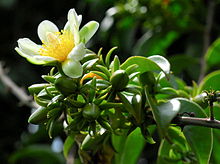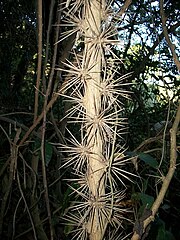Pereskia aculeata
| Pereskia aculeata | |
|---|---|

| |
| Scientific classification | |
| Kingdom: | Plantae |
| Clade: | Tracheophytes |
| Clade: | Angiosperms |
| Clade: | Eudicots |
| Order: | Caryophyllales |
| Family: | Cactaceae |
| Genus: | Pereskia |
| Species: | P. aculeata
|
| Binomial name | |
| Pereskia aculeata | |
| Synonyms[2] | |
| |
Pereskia aculeata is a scrambling shrub in the family Cactaceae. Common names include Barbados gooseberry, blade-apple cactus, leaf cactus, rose cactus, and lemonvine.[3] It is native to tropical America. The leaves and fruits are edible, containing high quantities of protein, iron and other nutrients, and it is a popular vegetable in parts of the Brazilian state of Minas Gerais under the name of ora-pro-nóbis.
Description
Like other members of the genus Pereskia, these plants are unusual cacti with spiny non-succulent stems and large leaves.
It is a scrambling vine growing to 10 m (33 ft) tall in trees, with stems 2–3 cm (0.79–1.18 in) thick. Younger stems have hooked thorns and older stems have clusters of woody spines. The leaves are 4–11 cm (1.6–4.3 in) long and 1.5–4 cm (0.59–1.57 in) broad, simple, entire, and deciduous in the dry season. The strongly scented flowers are white, cream or pinkish, 2.5–5 cm (0.98–1.97 in) diameter, and numerous, produced in panicles. The fruit is a rounded berry, translucent white to pink, yellow, orange or red, and 2 cm (0.79 in) in diameter. The leaves are edible, containing 20 to 30% of protein in the dry leaf matter. The fruit are also edible, containing numerous small seeds. It somewhat resembles the gooseberry in appearance and is of excellent flavor.
Distribution
Native
Panama, French Guiana, Guyana, Suriname, Venezuela, Brazil, Colombia, Argentina and Paraguay.
Introduced
Antigua and Barbuda, Barbados, Cuba, Dominica, Dominican Republic, Guadeloupe, Haiti, Martinique, Montserrat, Puerto Rico, Saint Vincent and the Grenadines, Trinidad and Tobago, Virgin Islands (U.S.), United States, Mexico, South Africa and Australia.
Ecological significance
A flea-beetle (Phenrica guerini) and a leaf-mining moth (Epipagis cambogialis), feed on the leaves.
Although Pereskia aculeata is edible and of high nutrition quality, being an alternative to conventional food, this plant is a declared weed in South Africa where it does extensive damage to forest areas by smothering indigenous trees. Infestations occur in some KwaZulu-Natal forests and are embedded in the canopy and difficult to remove. The plant has a tendency to form large, impenetrable clumps and the spines on the stems make control of large infestations difficult. The plants can regrow from leaves or pieces of stem. One specimen that had infested a tree had its stems cut at the base, but after four years the 'dry' stems of the Pereskia that fell from the tree still set root and regrew.[4]
Control
These plants are extremely difficult to kill and eradicate. It can be controlled by triclopyr or biological control with the leaf-feeding flea-beetle, Phenrica guerini, which has caused significant damage to Pereskia plants at Port Alfred, Eastern Cape, South Africa, but although the beetle was also released widely in KwaZulu-Natal, it has not become established there.[5]
Gallery
-
An old cut stem showing regrowth despite not being in contact with the ground
-
Growing in Ein Gedi Botanical Gardens
-
Mature stem at Ilanda Wilds
-
Centennial Park Conservatory, Toronto
References
- ^ Taylor (2002). "Pereskia aculeata". IUCN Red List of Threatened Species. 2002. Retrieved 9 May 2006. Database entry includes a brief justification of why this species is of least concern
- ^ "The Plant List: A Working List of All Plant Species". Retrieved 16 May 2014.
- ^ USDA GRIN Taxonomy, retrieved 3 May 2016
- ^ Purves et al. (1995) [full citation needed]
- ^ Klein, H. (1999). "Biological control of three cactaceous weeds, Pereskia aculeata Miller, Harrisia martinii (Labouret) Britton and Cereus jamacaru De Candolle in South Africa". African Entomology Memoir (1): 3–14. S2CID 55993058. AGRIS id ZA2001000773. CABI ISC 19992302942.
- Grocer's Encyclopedia: The Encyclopedia of Food and Beverage, by Artemas Ward, New York, 1911.
- http://www.hear.org/Pier/wra/pacific/pereskia_aculeata_htmlwra.htm
- Pooley, E. (1998). A Field Guide to Wild Flowers; KwaZulu-Natal and the Eastern Region. ISBN 0-620-21500-3.





